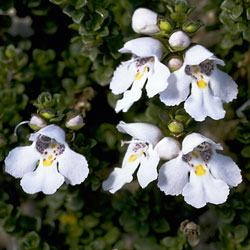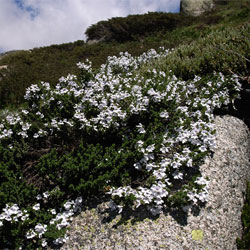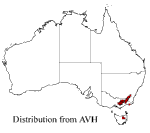Prostanthera cuneata
 |
 |
Alpine mint-bush
Prostanthera cuneata or the Alpine Mint Bush is a member of the family Lamiaceae, which has over 20 genera in Australia. It is found in alpine and subalpine heathlands of Victoria, NSW and the ACT, between the elevations of 1200-1500 m. Apart from cultivated plants, it is now considered to be extinct in Tasmania, which was the first state it was described in. It grows in sheltered and exposed sites, on acidic loams to gravely or stony soils.
 P. cuneata is a dense, evergreen shrub to around 1 m tall which also comes in a prostrate form. It has long or soft shaggy hairs on strong, woody branches that can carry the weight of snow that covers it in winter. A distinguishing feature is the shiny, wedge-shaped leaves, which are dotted with oil glands. When the leaves are crushed they emit a lovely minty, eucalyptol fragrance.
P. cuneata is a dense, evergreen shrub to around 1 m tall which also comes in a prostrate form. It has long or soft shaggy hairs on strong, woody branches that can carry the weight of snow that covers it in winter. A distinguishing feature is the shiny, wedge-shaped leaves, which are dotted with oil glands. When the leaves are crushed they emit a lovely minty, eucalyptol fragrance.
The flowers are a very attractive trumpet-shape, coloured white with many purple, red or yellow blotches in the throat. Many insects, especially bees are attracted to this flower, which contains a reserve of nectar. P. cuneata flowers from November through to April, and fruits from December to March. The shrub form is lovely in a pot on the windowsill or next to a pathway where the scent may be enjoyed. The prostrate form makes an excellent ground cover and looks lovely in a rockery with its dense, shiny foliage and delicate, white flowers.
P. cuneata prefers well-drained, moist conditions and is known to have a higher resilience to phosphorus than many other Australian plants. It prefers regular watering, and leaves exposed to sunlight should not be allowed to become wet. It is frost and snow tolerant, responds well to tip pruning.
P. cuneata is usually free from pests and diseases; however it is susceptible to root pathogens, such as Phytophthora cinnamomi and may be short lived in cultivation. This may be alleviated through the purchase of tougher clones, which are now available.
P. cuneata is very easy to propagate. Half-ripened tip cuttings from 5-15 cm long should be taken in the shade and treated with a mild hormone immediately to avoid wilting. If the cuttings are not going to be processed straight away, place in a plastic bag and leave in a domestic fridge until time of replanting. A freshly potted plant should have a gradual increase in sunlight as new growth forms and watered everyday for the first week. P. cuneata will grow readily from seed and doesn't require any special treatment before planting.
This species adds a lovely fragrance to any garden and is easily admired for its dark, evergreen foliage and pretty flowers.Text by Alice Rentsch (2005 Student Botanical Intern)
Derivation of the name: Prostanthera cuneataProstanthera – from the Greek words prostheke, an appendage and antheros, anthers, referring to the spur-like appendage of the anthers. cuneata - refers to the cuneate or wedge-shaped leaves. |
References
Althofer, G.W. (1978) Cradle of Incense. Stanley Smith Memorial Publication Fund.
Conn, B.J. (1997) Contributions to the systematics of Prostanthera (Labiatae) in south eastern Australia. Telopea 7(4): 319-332.
Elliot, W. R. & Jones, D.L. (2002) Encyclopaedia of Australian Plants Suitable for Cultivation. Vol. 8. Pr-So. Lothian Publishing.
Greig, D. (1996) Flowering Natives for Home Gardens. Cornstalk Publishing.
Macdonald, R.G. & Harris, T.Y. (1980) Mintbushes and their Relatives. The David G. Stead Memorial Wildlife Research Foundation of Australia.
Wrigley, J.W. & Fagg, M. (1996) Australian Native Plants- Propagation, Cultivation and Use in Landscaping. 4 th ed. Reed Books Australia.
![An Australian Government Initiative [logo]](/images/austgovt_brown_90px.gif)

